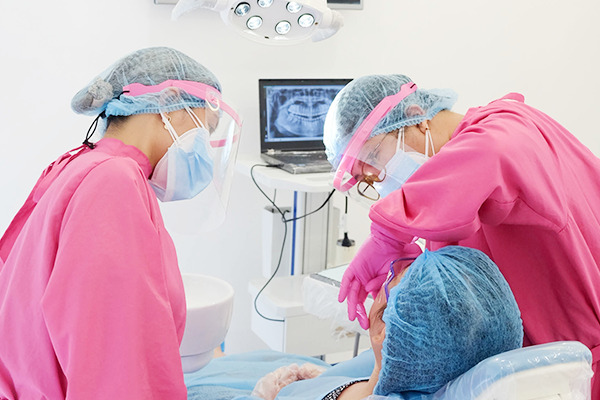Wisdom Teeth Removal
Third molars or wisdom teeth are the last set of teeth to erupt. They are called wisdom teeth because they emerge at a more mature age, either in your late teens or early twenties. Most adults have four wisdom teeth, one in each of the four quadrants. Some people may only have a few, some may have none at all and some may have more than four (supernumerary teeth).
Because wisdom teeth show up much later than the rest of your teeth, they normally don’t have enough space to grow in your jaw. This is the reason why some wisdom teeth emerge misaligned and some become impacted.

Do you have to remove Wisdom Teeth?
Wisdom teeth are considered as a vestigial organ like the human appendix. Vestigial organs are anatomical structures of the body that have lost their purpose or function in human evolution. Their presence or absence does not affect normal biological function.
Wisdom teeth do not serve any purpose in your mouth. They may be safely removed without compromising any function. Your dentist may recommend wisdom teeth removal depending on how your wisdom teeth are erupted, positioned and how they affect your oral health.
1. Healthy Wisdom Teeth
Wisdom teeth that are healthy, fully erupted and correctly positioned don’t have to be removed as long as they do not affect your bite, cause pain or lead to other dental problems. Just make sure that you are able to clean them properly.
2. Misaligned Wisdom Teeth
Some wisdom teeth emerge fully but not correctly. Misaligned wisdom teeth are either positioned horizontally, angled inwards or outwards or angled towards or away from the second molars.
Misaligned wisdom teeth are recommended for removal because they can damage the second molars, the jawbone and nerves. Misaligned wisdom teeth can also cause orthodontic problems such as crowding. They can cause your other teeth to bunch up, overlap or twist due to the lack of space in your jaw.
3. Impacted Wisdom Teeth
Impacted wisdom teeth are third molars that fail to erupt fully because of the lack of space in your jaw or because they are blocked by other teeth from erupting. There are basically three types of wisdom teeth impaction:
- Soft Tissue Impaction – Wisdom teeth are partially erupted and are covered by gum tissue.
- Partial Bony Impaction – Wisdom teeth are partially erupted but part of the crown is trapped below the gum line and in the jawbone.
- Complete Bony Impaction – Wisdom teeth are completely encased in the jawbone.
Impacted wisdom teeth are indicated for surgical extraction. Aside from causing inflammation and pain, impacted wisdom teeth can also cause recurrent infections, severe tooth decay, periodontal disease, and in some cases, cause cysts or even tumors to develop.
What is the process of Wisdom Teeth Extraction?
A wisdom tooth extraction is usually an outpatient procedure. The procedure can be simple or complicated depending on the position and the type of eruption of the wisdom teeth. Some cases may require a surgical approach that involves making an incision in the gums and removing bone to extract the tooth
1. Consultation
The first step to having your wisdom teeth removed is consultation. During the consultation, our oral surgeon will personally examine your teeth, evaluate your case, advise you of your options and provide you with a treatment plan. Photographs and x-rays of your teeth will also be taken during your consult. For some cases, a CBCT Scan may also be required.
If you have any infections, the oral surgeon will prescribe antibiotics first and will delay surgery until the infection has cleared up. The oral surgeon will also provide you instructions on what to do before the surgery and on the day of your scheduled surgery.

2. Anesthesia
Depending on what you and the oral surgeon discussed during the consultation, you may either undergo surgery using local anesthesia only or conscious sedation:
- Local anesthesia – The oral surgeon shall numb your gums with a topical substance before injecting local anesthesia at the site of extraction. You are fully awake and may feel some pressure or movement exerted by the oral surgeon during the surgery but will not experience any pain.
- Sedation anesthesia – An anesthesiologist will administer sedation anesthesia through an intravenous (IV) line in your arm. Sedation anesthesia or conscious sedation will fully relax you, suppress your consciousness and even make you fall asleep during the procedure. You will not experience any pain during the procedure and will have very limited memory of the surgery after.

3. Surgery
After administering anesthesia, the oral surgeon shall proceed to removing the wisdom tooth. The gum tissue covering the tooth will be opened up. The oral surgeon may also take out any bone that is covering the tooth. The tissue connecting the tooth to the bone will then be separated.
The oral surgeon will then proceed to removing the tooth. Complicated cases may require cutting the tooth into smaller pieces to remove them. After the tooth is removed, the oral surgeon will stitch the gums. Some stitches dissolve over time and some have to be removed after a few days.

4. Recovery
After the surgery, you will be asked to stay to recover first if you underwent sedation. Before you are dismissed, the oral surgeon will be providing you with post-operative instructions. You might also be prescribed pain relievers and if needed, antibiotics.
You will be asked to visit after a dew days to check the progress of your healing and/or to remove stitches.
Congratulations! You made it!

DISCOVER YOUR OPTIONS. VISIT US TODAY!
Clinics
Makati
2F, Plaza One Hundred, 100 V.A. Rufino St., Legaspi Village, Makati City
(02) 8823-5571
(+63) 917-584-6852
makati@affinitydentalclinics.com
BGC Stop Over
BGC High Street
Alabang
Cebu
Ortigas
(+63) 917-632-1128

Follow us on Social Media
Copyright 2018, Affinity Dental Clinics. All Rights Reserved.